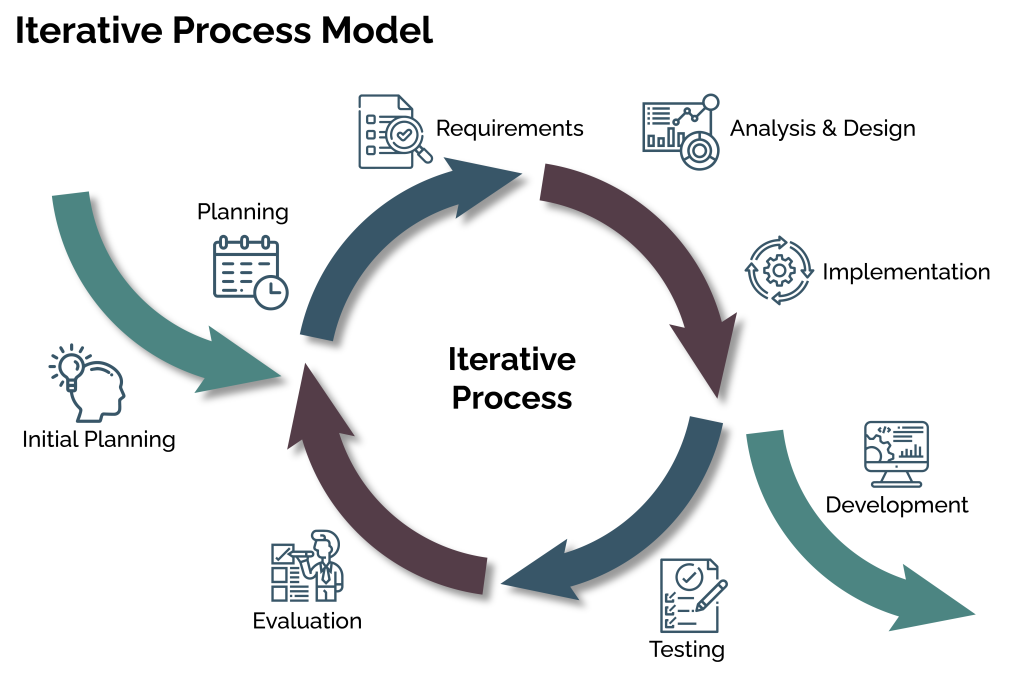Iterative design is a design methodology based on a cyclical approach of prototyping, testing, analyzing, and refining a product at any stage of the design process. You can think of iterative design as a rapid and repetitive trial-and-error process intended to deliver a product that meets user goals and expectations. How users say they behave with a digital product versus how they behave is rarely the same. The iterative design recognizes this by laying a framework for product teams to develop a prototype quickly and then test it with real-world users to determine what they do with the product.
 When to use the iterative design?
When to use the iterative design?
Designers can apply an iterative approach at any stage of the product development process. Organizations can even introduce or adopt iterative design even if a product has already been shipped to market, especially if they’re looking to make improvements. However, the earlier iterative design is implemented in the product lifecycle, the more likely the product can meet user objectives and expectations. Further, it’s also more likely that the design process can be more cost-effective and achieve faster time to market.
What is a non-iterative approach?
The Waterfall model is the most common non-iterative process wherein each project phase (e.g., discovery, conceptualization, design, development, testing, launch) must be completed in its entirety before moving on to the next one. In a non-iterative approach, as in the waterfall model, teams emphasized the planning phase more than the execution process — documenting everything in advance, such as the user interface, user stories, and all features and variations. Non-iterative methods require more time during the conceptualization and creation phase, aiming for the product to work as intended during testing.
Requirements and resources are typically locked after project planning, and teams avoid project modifications as much as possible. Typically, teams design and develop a final product with the minimal exploration of new ideas along the way. Non-iterative design processes can be challenging because it doesn’t allow time and space for unknowns and surprises and the necessary adjustments to address them.
What are the benefits of iterative design?
Companies and organizations of all shapes and sizes have lauded adopting an iterative approach to their design and development processes. Here are the key benefits of iterative design:
● Efficiency: By working on products in quick sprints, teams can adjust their products in each iteration rather than rework an entire design as new insights or feedback emerge. Further, workload among team members can be spread out more evenly throughout the development lifecycle.
● Progress visibility: Iterative design gives product stakeholders visibility of a project’s progress at the end of each iteration.
● Collaboration: Designers can generate feedback from clients and stakeholders based on the results from each iteration. An iterative process draws better engagement from them as they can see the evolution of the project and that the design team is meeting their requirements rather than “dumping” a finished product on them.
● Eliminates confusion: The repetitive or cyclical nature of iterative design enables rapid resolution of misunderstandings or disorders within the project team as early as possible. Further, teams can detect flaws in the design, architecture, code, and other implementations with each iteration, severely impacting the product if left undetected.
● Ability to work in parallel: Unlike non-iterative methodologies such as the waterfall method, the iterative process decreases dependence on the work that comes in previous phases. Team members can work on several parts of a project in parallel, leading to faster time to market.
● Usability: Iterative design keeps users at the heart of the process, with each iteration ideally based on user research, behavior, and feedback. For instance, testing and debugging in smaller or faster iterations can identify defects or flaws early in the design process, with target users providing insight in each iteration.
● Continuous improvement: Each iteration enables design teams to incorporate lessons learned from previous runs giving the final product the best chance to meet customer expectations.
● Cost-effective: Changes arising from an iterative approach are likely to be less costly than in a Waterfall approach. Since modifications are common in product development, discovering them at the earliest possible stage makes it easier for organizations to adjust their resources.
Examples of iterative design
Here are some familiar examples of iterative design:
● Iteration during product development: Engineering teams apply an iterative approach in developing new features, implementing bug fixes, and A/B testing new strategies. It’s not uncommon for engineering teams to create a few promising versions, then test them out with users. They’ll note good and bad user experiences and then continue building the iteration that tested the best.
● Wikis: With user-generated content, anyone can write new entries or improve existing ones. Reviewers or editors then decide whether new content passes specific standards or whether the changes made improve the content. Users expect this iteration system in sites like Wikipedia to present the best available information on any given topic over time.
● Urban design: Urban designers see 10-year plans made by local governments as strategies and principles. Urban designers execute new ideas at a small scale and gather feedback before expanding their programs for implementation. For instance, they may try a living street design for one year before scaling them either at the exact location or in another area.
Good design requires iteration.
Iterative design enables product designers to build and test products quickly. As a result, features and functionalities that resonate with users can be improved further while those can’t be soon abandoned or modified. The iterative process is an efficient design approach, which puts user experience at the heart of product development.
Will you be working on a project that can benefit from iterative design? Reach out to our experts at Radiant Digital to learn more about our product design and development process.


